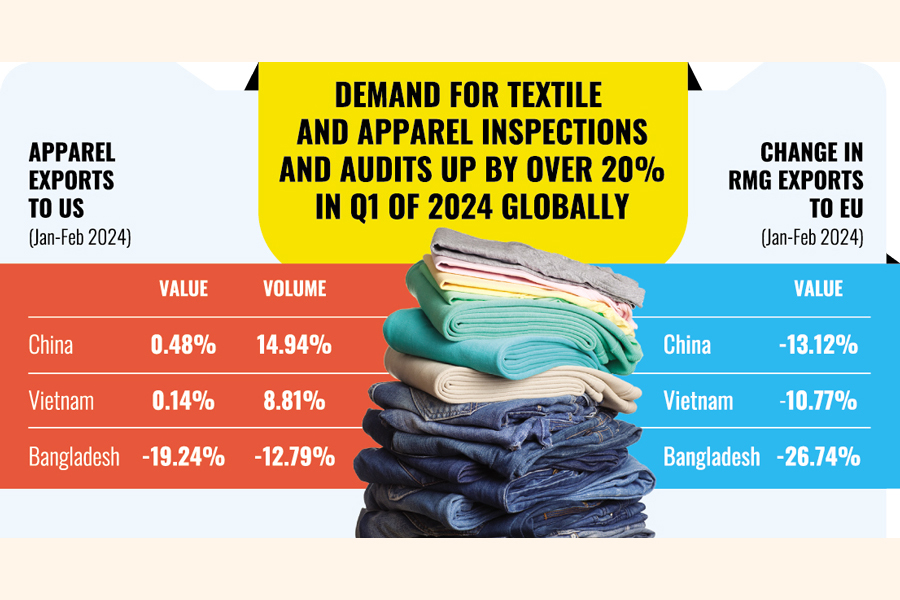Apparel demand resurgence in West promises new bonanza
Bangladesh lags as China, Vietnam bag windfall with export upturn

Published :
Updated :

A significant bounceback in global demand for textiles and apparel promises new opportunity but Bangladesh lags far behind China in bagging the bonanza for reasons that include recent cost escalation.
Records of inspections and audits among buyers for China show the giant economy had a double-digit growth in recent months, according to latest report.
Similar trend is also reflected in both US and EU official import data for the first two months of 2024.
Global demand for textile and apparel inspections and audits from garment- manufacturing countries, including Bangladesh, increased over 20 per cent in the first quarter of 2024, according to QIMA latest report.
During the period, demand for China inspections and audits among US-based buyers grew over 12 per cent year on year (YoY), while among European brands, the growth was even faster, especially from buyers based in Germany with more than 35-percent YoY growth followed by France over 30 per cent, and the Netherlands over 33 per cent.
Meanwhile, "interest in China's manufacturing capacities remained robust among buyers in other parts of Asia, as well as in Latin and South America, with double-digit growth in inspection and audit demand across the board", the report adds.
QIMA, a quality-control company, in its latest report revealed that "following a slow 2023, demand for textile and apparel inspections and audits were up by more than 20 per cent YoY in Q1 2024 globally."
This swell in procurement can be linked to multiple factors, such as fading recession fears and improved consumer sentiment in the West, inventory replenishment following the holiday season, as well as brands relying on larger shipments to mitigate longer freight- transit times on routes affected by the Red Sea crisis, it explains why such a spurt in trade.
The report, however, says while China is experiencing resurgence in popularity among apparel brands, its competitors in Asia and beyond are keeping pace.
Regarding Bangladesh, the QIMA report says: "Both US- and EU-based brands stepped up their procurement in Bangladesh, instilling optimism that the country's export sector will perform better this year compared to 2023, when a political crisis halted a significant portion of Bangladesh's manufacturing."
"Whether that optimism will pan out remains to be seen, as the industry has some concerns about the Bangladeshi government's recent policy move to reduce cash incentives for garment exports."
QIMA is currently operating in more than 100 countries offering supplier audit, laboratory testing and product-inspection services in Asia, Africa, Australia, Europe and North America and South America.
According to OTEXA data, Bangladesh's readymade garment exports to the USA totalled $1.18 billion in January and February of 2024, recording a 19.24-percent decrease compared to the $1.46 billion earned in the corresponding period of 2023.
The US imported 395.69 million square metres of apparel items from Bangladesh in the January-February period this year which was about 12.79-percent lower than the 453.73 million square metres shipped in January-February 2023.
In contrast, during the January- to February period of 2024, China's apparel exports to the US grew by 0.48 per cent in value and 14.94 per cent in volume while Vietnam's apparel exports to the US increased 0.14 per cent in value and 8.81 per cent in volume.
In January-February 2024, Bangladesh's RMG exports to the EU recorded a 26.74- percent decline to 2.48 billion euros compared to 3.39 billion euros in the corresponding period of 2023, according to data of Eurostat, the statistical office of the European Union.
In contrast, China's apparel exports to the EU market during the first two months of 2024 dropped by 13.12 per cent to 3.33 billion euros.
EU's apparel imports from Vietnam during the period decreased by 10.77 per cent to 596.70 million euros, according to Eurostat data.
When asked, Fazlul Hoque, former president of Bangladesh Knitwear Manufacturers and Exporters Association (BKMEA), agreed with the trend shown in the QIMA findings.
He says China is more desperate than Bangladesh to grab the orders and it is offering lower prices, too.
In contrast, Bangladesh has no chance to go desperate in this regard as recent rises in wages, utility charges and other costs have pushed up the production cost, he noted.
"Even the forecast also gives the indication of further hike in gas prices," he says about the downside pulls.
Mahmud Hasan Khan, a former leader of Bangladesh Garment Manufacturers and Exporters Association, knows a bit different about the trade milieus. He told the FE that they are getting good inquiries from buyers.
Previously seasonal difference from country to country was four months while it now stands at two months as they have buyers from not only the US and the EU but also from new markets like Australia, Japan, India and Korea where Bangladesh shipped goods worth more than US$4.0 billion, he said.
He, however, expressed concern about the future, saying they are producing orders "but cost of doing business has been increasing due to gas and electricity issues".
They are not getting benefits rather retention has been decreasing, he said, adding that cut in cash incentives also affects them badly.


 For all latest news, follow The Financial Express Google News channel.
For all latest news, follow The Financial Express Google News channel.